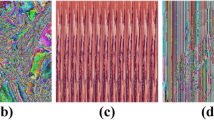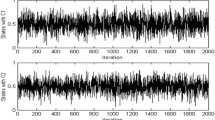Abstract
Recently, the digital multimedia security technology has been an interesting research theme due to fast advancement in employing real time multimedia through Internet and wireless networks. The market of multimedia streaming, such as exclusive video on demand (VoD) is a huge multi- billion-dollar market. This market is threatened by hackers. The multimedia streaming industry needs a cryptosystem that is both fast and secure. Chaotic cryptosystems have been proposed by many researchers in order to promote communication security. However, these chaotic schemes have some major problems, such as unacceptable expansion of data, slow performance speed, and shortcomings against differential attack. Therefore, this paper provides an efficient Fractional Fourier Transform (FrFT)-based logistic map (LM) color image encryption scheme by applying a 2D LM on FrFT. In the proposed FrFT-based LM color image encryption scheme, the 2D LM is employed as a confusion step to scramble the color image pixel positions in the FrFT and confuse the relationship between the cipherimage and the plainimage. For enhancing the encryption performance characteristics of the 2D LM under the FrFT, the angle of the FrFT is taken as an extra additional key in encryption. The proposed FrFT-based LM color image encryption scheme is examined and investigated using visual inspection, entropy, histograms, encryption quality, noise tests, and differential analysis. The obtained simulation tests demonstrate and verify the effectiveness of the FrFT-based LM color image encryption scheme. Moreover, our results also show a significant improvement in the performance of the confusion property with our proposed 2D LM encryption scheme using the FrFT. Also, we compared the proposed cryptosystem with recent state-of-the-art cryptosystems. Experimental results show that our proposed image cryptosystem is highly secure from the cryptographic point of view. Furthermore, the obtained test results ensured the superiority of our proposed cryptosystem for digital image transmission compared to the recent state-of-theart cryptosystems.






Similar content being viewed by others
References
Abu-Marie W, Gutub A, Abu-Mansour H (2010) Image Based Steganography Using Truth Table Based and Determinate Array on RGB Indicator. International Journal of Signal & Image Processing 1(3)
Alanazi, N, Alanizy, A, Baghoza, N, Al Ghamdi, M, Gutub, A (2018). 3-Layer PC Text Security via Combining Compression, AES Cryptography 2LSB Image Steganography
Alassaf N, Alkazemi B, Gutub A (2003) Applicable light-weight cryptography to secure medical data in IoT systems. Arabia
Alassaf N, Gutub A, Parah S, Ghamdi A, Manal (2018) Enhancing speed of SIMON: A light-weight-cryptographic algorithm for IoT applications. Multimed Tools Appl. https://doi.org/10.1007/s11042-018-6801-z
Al-Ghamdi M, Al-Ghamdi M, Gutub A (2018) Security enhancement of shares generation process for multimedia counting-based secret-sharing technique. Multimed Tools Appl:1–28
Aljawarneh SA, Moftah RA, Maatuk AM (2016) Investigations of automatic methods for detecting the polymorphic worms signatures. Futur Gener Comput Syst 60:67–77
Aljawarneh S, Yassein MB (2017) A resource-efficient encryption algorithm for multimedia big data. Multimed Tools Appl 76(21):22703–22724
Aljawarneh S, Yassein MB (2018) A multithreaded programming approach for multimedia big data: encryption system. Multimed Tools Appl 77(9):10997–11016
Aljuaid N, Gutub A, Khan E (2018) Enhancing PC Data Security via Combining RSA Cryptography and Video Based Steganography. Journal of Information Security and Cybercrimes Research (JISCR) 1. https://doi.org/10.26735/16587790.2018.006
Al-Otaibi NA, Gutub AA (2014) 2-leyer security system for hiding sensitive text data on personal computers. Lecture Notes on Information Theory 2(2):151–157
Alsaidi A, Al-lehaibi K, Alzahrani H, AlGhamdi M, Gutub A (2018) Compression multi-level crypto stego security of texts utilizing colored email forwarding. Journal of Computer Science & Computational Mathematics (JCSCM) 8(3):33–42
Alsmirat MA, Al-Alem F, Al-Ayyoub M et al (2019) Impact of Digital Fingerprint Image Quality on the Fingerprint Recognition Accuracy. Multimed Tools Appl 78:3649. https://doi.org/10.1007/s11042-017-5537-5
Amin M, Faragallah OS, El-Latif AAA (2010) A chaotic block cipher algorithm for image cryptosystems. Commun Nonlinear Sci Numer Simul 15(11):3484–3497
Atawneh S, Almomani A, Al Bazar H, Sumari P, Gupta B (2017) Secure and imperceptible digital image steganographic algorithm based on diamond encoding in DWT domain. Multimed Tools Appl 76(18):18451–18472
Chai X, Chen Y, Broyde L (2017) A novel chaos-based image encryption algorithm using DNA sequence operations. Opt Lasers Eng 88:197–213
Chen JX, Zhu ZL, Fu C, Yu H (2015) Optical image encryption scheme using 3-D chaotic map based joint image scrambling and random encoding in gyrator domains. Optics Comm 341:263–270
Chen J, Zhu ZL, Zhang LB, Zhang Y, Yang BQ (2018) Exploiting self-adaptive permutation–diffusion and DNA random encoding for secure and efficient image encryption. Signal Process 142:340–353
Elhosany HM, Hossin HE, Kazemian HB, Faragallah OS (2012) C9. Chaotic encryption of images in the Fractional Fourier Transform domain using different modes of operation. In Radio Science Conference (NRSC), 2012 29th National (pp. 223-235). IEEE
El-Latif AAA, Abd-El-Atty B, Hossain MS, Rahman MA, Alamri A, Gupta BB (2018) Efficient quantum information hiding for remote medical image sharing. IEEE Access 6:21075–21083
Guesmi R, Farah MAB, Kachouri A, Samet M (2016) Hash key-based image encryption using crossover operator and chaos. Multimed Tools Appl 75(8):4753–4769
Gupta BB (2018) Computer and Cyber Security: Principles, Algorithm, Applications, and Perspectives. CRC Press, Taylor & Francis 666
Gupta B, Agrawal DP, Yamaguchi S (2016) Handbook of Research on Modern Cryptographic Solutions for Computer and Cyber Security (1st ed.). IGI Global, Hershey
Gutub AAA (2010) Pixel indicator technique for RGB image steganography. Journal of Emerging Technologies in Web Intelligence 2(1):56–64
Gutub A, Al-Ghamdi M (2019) Image Based Steganography to Facilitate Improving Counting-Based Secret Sharing. 3D Res 10(1):6
Gutub A, Aljuaid N (2018) Multi-bits stego-system for hiding text in multimedia images based on user security priority. https://doi.org/10.63019/jche.v1i2.513
Gutub A, Al-Juaid N, Khan E (2019) Counting-based secret sharing technique for multimedia applications. Multimed Tools Appl 78(5):5591–5619
Gutub AAA, Khan FAA (2012) Hybrid crypto hardware utilizing symmetric-key and public-key cryptosystems. In 2012 International Conference on Advanced Computer Science Applications and Technologies (ACSAT) (pp. 116-121). IEEE
Hamza R, Yan Z, Muhammad K, Bellavista P, Titouna F (2019) A privacy-preserving cryptosystem for IoT E-healthcare. Inf Sci
Jiang X, Sun J, Li C, Ding H (2018) Video Image Defogging Recognition Based on Recurrent Neural Network. IEEE Transactions on Industrial Informatics 14(7):3281–3288
Kong D, Shen X (2014) Multiple-image encryption based on optical wavelet transform and multichannel fractional Fourier transform. Opt Laser Technol 57:343–349
Li Y, Wang C, Chen H (2017) A hyper-chaos-based image encryption algorithm using pixel-level permutation and bit-level permutation. Opt Lasers Eng 90:238–246
Li J, Yu C, Gupta BB, Ren X (2018) Color image watermarking scheme based on quaternion Hadamard transform and Schur decomposition. Multimed Tools Appl 77(4):4545–4561
Mary SJ, Christopher CS, Joe SSA (2016) Novel scheme for compressed image authentication using LSB watermarking and EMRC6 encryption. Circuits and Systems 7(08):1722
Özkaynak F, Özer AB (2016) Cryptanalysis of a new image encryption algorithm based on chaos. Optik-International Journal for Light and Electron Optics 127(13):5190–5192
Parvez M, Gutub A (2011) Vibrant color image steganography using channel differences and secret data distribution. Kuwait Journal of Science and Engineering 38:127–142
Patidar V, Pareek NK, Sud KK (2009) A new substitution–diffusion-based image cipher using chaotic standard and logistic maps. Commun Nonlinear Sci Numer Simul 14(7):3056–3075
Ran Q, Zhao T, Yuan L, Wang J, Xu L (2014) Vector power multiple-parameter fractional Fourier transform of image encryption algorithm. Opt Lasers Eng 62:80–86
Seyedzadeh SM, Mirzakuchaki S (2012) A fast color image encryption algorithm based on coupled two-dimensional piecewise chaotic map. Signal Process 92(5):1202–1215
Wang XY, Yang L, Liu R, Kadir A (2010) A chaotic image encryption algorithm based on perceptron model. Nonlinear Dynamics 62(3):615–621
Wang XY, Zhang YQ, Bao XM (2015) A novel chaotic image encryption scheme using DNA sequence operations. Opt Lasers Eng 73:53–61
Xu L, Gou X, Li Z, Li J (2017) A novel chaotic image encryption algorithm using block scrambling and dynamic index-based diffusion. Opt Lasers Eng 91:41–52
Yavuz E, Yazıcı R, Kasapbaşı MC, Yamaç E (2016) A chaos-based image encryption algorithm with simple logical functions. Comput Electr Eng 54:471–483
Ye G, Huang X (2016) A secure image encryption algorithm based on chaotic maps and SHA-3. Security and Communication Networks 9(13):2015–2023
Yu C, Li J, Li X et al (2018) Four-image encryption scheme based on quaternion Fresnel transform, chaos and computer-generated hologram. Multimed Tools Appl 77:4585. https://doi.org/10.1007/s11042-017-4637-6
Zhu ZL, Zhang W, Wong KW, Yu H (2011) A chaos-based symmetric image encryption scheme using a bit-level permutation. Inf Sci 181(6):1171–1186
Zou L, Sun J, Gao M, Wan W, Gupta BB (2019) A novel coverless information hiding method based on the average pixel value of the sub-images. Multimed Tools Appl 78(7):7965–7980
Author information
Authors and Affiliations
Corresponding author
Additional information
Publisher’s note
Springer Nature remains neutral with regard to jurisdictional claims in published maps and institutional affiliations.
Rights and permissions
About this article
Cite this article
Faragallah, O.S., AlZain, M.A., El-Sayed, H.S. et al. Secure color image cryptosystem based on chaotic logistic in the FrFT domain. Multimed Tools Appl 79, 2495–2519 (2020). https://doi.org/10.1007/s11042-019-08190-z
Received:
Revised:
Accepted:
Published:
Issue Date:
DOI: https://doi.org/10.1007/s11042-019-08190-z




